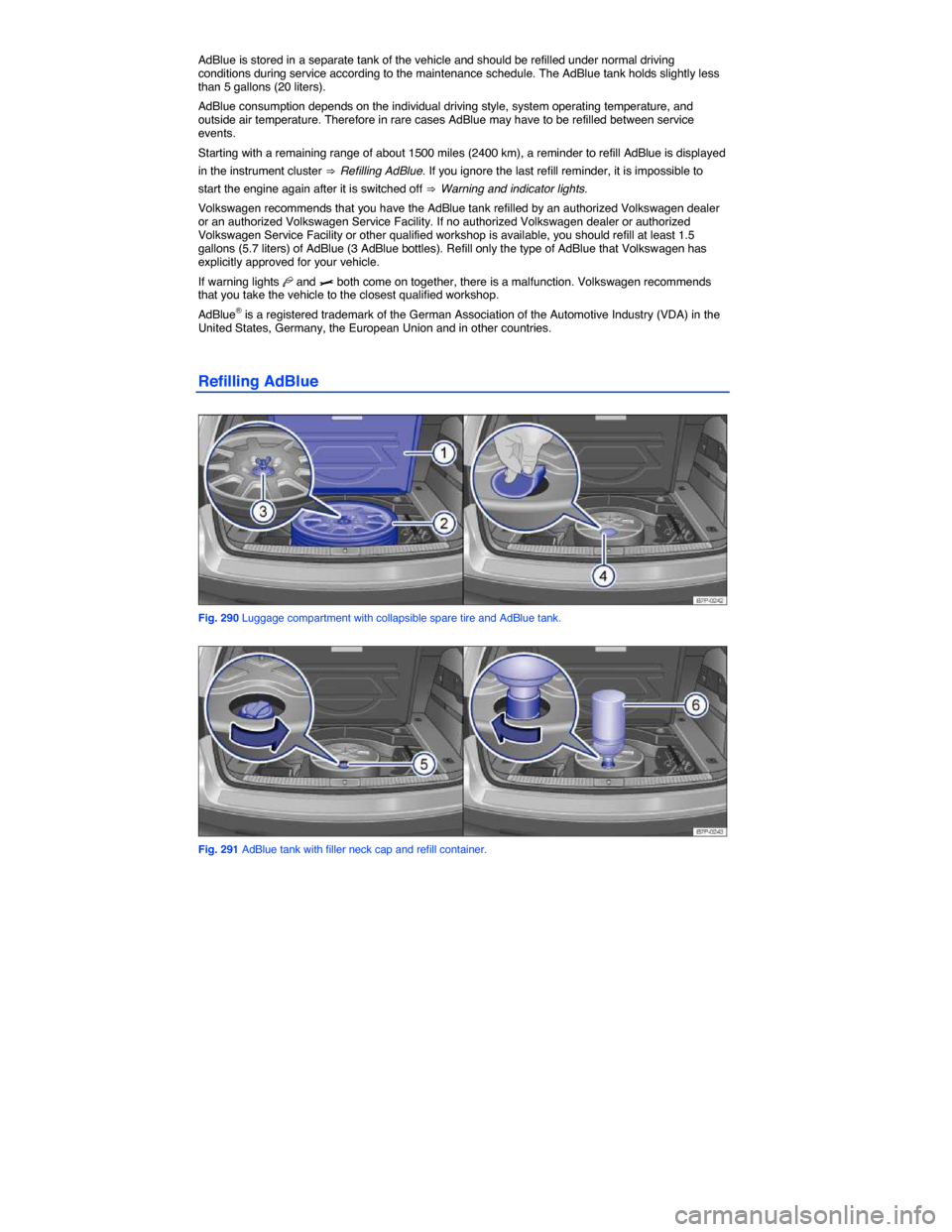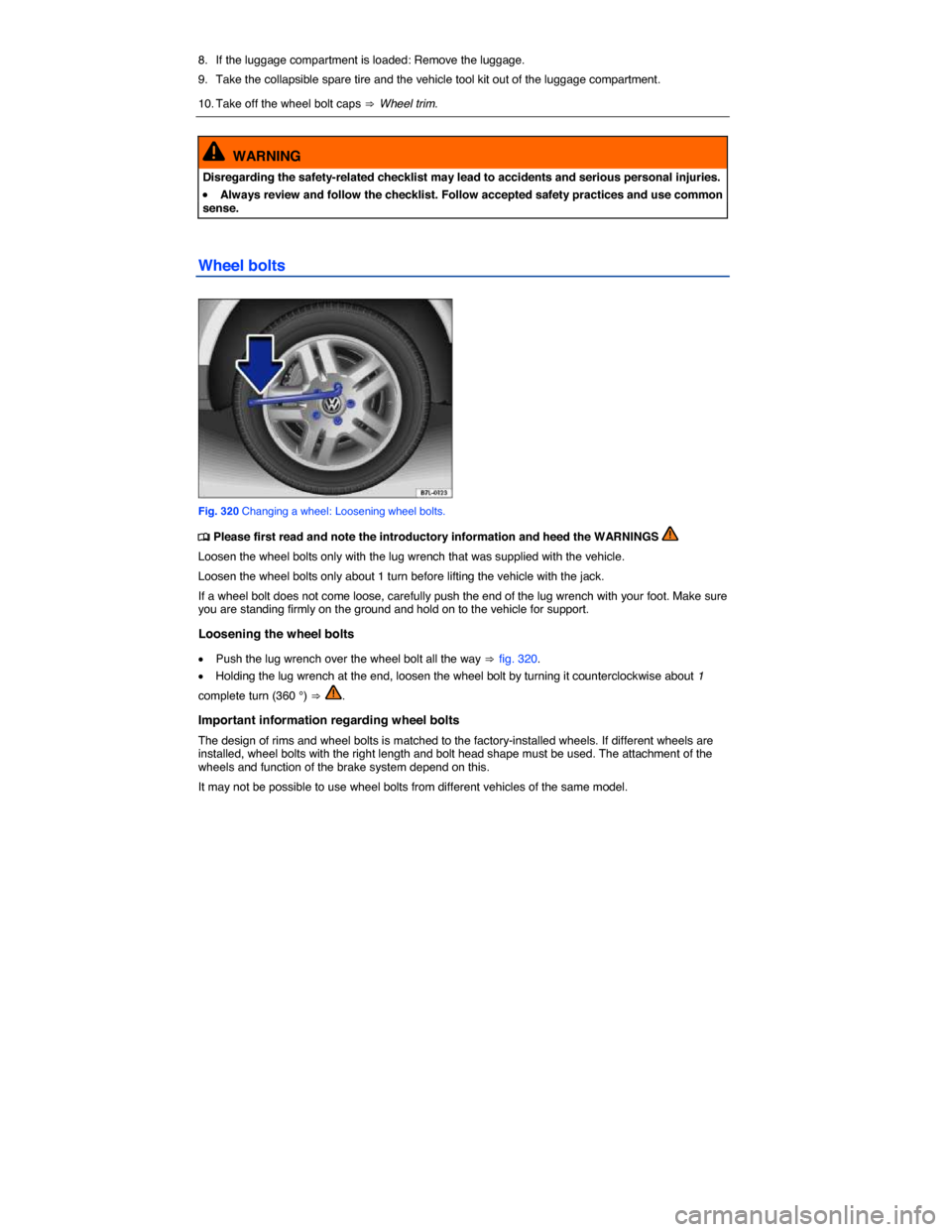2014 VOLKSWAGEN TOUAREG spare tire
[x] Cancel search: spare tirePage 200 of 620

placard or tire inflation pressure label, you should determine the proper tire inflation pressure for those tires.)
As an added safety feature, your vehicle has been equipped with a Tire Pressure Monitoring System (TPMS) that illuminates a low tire pressure telltale when one or more of your tires is significantly underinflated. Accordingly, when the low tire pressure telltale illuminates, you should stop and check your tires as soon as possible, and inflate them to the proper pressure. Driving on a significantly underinflated tire causes the tire to overheat and can lead to tire failure. Underinflation also reduces fuel efficiency and tire tread life, and may affect the vehicle's handling and stopping ability.
Please note that the TPMS is not a substitute for proper tire maintenance, and it is the driver's responsibility to maintain correct tire pressure, even if underinflation has not reached the level to trigger illumination of the TPMS low tire pressure telltale.
Your vehicle has also been equipped with a TPMS malfunction indicator to indicate when the system is not operating properly. The TPMS malfunction indicator is combined with the low tire pressure telltale. When the system detects a malfunction, the telltale will flash for approximately 1 minute and then remain continuously illuminated. This sequence will continue upon subsequent vehicle start-ups as long as the malfunction exists.
When the malfunction indicator is illuminated, the system may not be able to detect or signal low tire pressure as intended. TPMS malfunctions may occur for a variety of reasons, including the installation of replacement or alternate tires or wheels on the vehicle that prevent the TPMS from functioning properly. Always check the TPMS malfunction telltale after replacing one or more tires or wheels on your vehicle to ensure that the replacement or alternate tires and wheels allow the TPMS to continue to function properly.
Collapsible spare tire
The collapsible spare tire has no tire pressure sensor. When the collapsible spare tire is mounted on the vehicle, the Tire Pressure Monitoring System (TPMS) indicator light will flash in the instrument cluster display. The TPMS continues to monitor the other 3 wheels.
Tire storage
If the tires do not move for an extended period of time, the sensors will not transmit tire pressures to the system. This saves sensor battery life. When the ignition is switched on, the sensors transmit signals to the Tire Pressure Monitoring System.
WARNING
Incorrect tire pressure can cause sudden tire failure, loss of vehicle control and serious personal injury.
�x Incorrect tire pressure can cause sudden tire failure, loss of vehicle control and serious personal injury.
�x After that, always make sure that all 4 tires are inflated to the correct tire pressure for the tires installed on the vehicle.
�x See the tire pressure label ⇒ Tire inflation pressure and the Owner's Literature for recommended cold tire inflation pressure and other important information.
�x When replacing tires or wheel rims on vehicles equipped with TPMS, always read and
heed all of the information and WARNINGS ⇒ Tire inflation pressure.
NOTICE
�x The wheel electronics are attached to special aluminum valves on the wheels. These valves are screwed on rigidly. Never bend the valves “into position” when checking and adjusting tire pressure.
Page 443 of 620

AdBlue is stored in a separate tank of the vehicle and should be refilled under normal driving conditions during service according to the maintenance schedule. The AdBlue tank holds slightly less than 5 gallons (20 liters).
AdBlue consumption depends on the individual driving style, system operating temperature, and outside air temperature. Therefore in rare cases AdBlue may have to be refilled between service events.
Starting with a remaining range of about 1500 miles (2400 km), a reminder to refill AdBlue is displayed
in the instrument cluster ⇒ Refilling AdBlue. If you ignore the last refill reminder, it is impossible to
start the engine again after it is switched off ⇒ Warning and indicator lights.
Volkswagen recommends that you have the AdBlue tank refilled by an authorized Volkswagen dealer or an authorized Volkswagen Service Facility. If no authorized Volkswagen dealer or authorized Volkswagen Service Facility or other qualified workshop is available, you should refill at least 1.5 gallons (5.7 liters) of AdBlue (3 AdBlue bottles). Refill only the type of AdBlue that Volkswagen has explicitly approved for your vehicle.
If warning lights �b and �> both come on together, there is a malfunction. Volkswagen recommends that you take the vehicle to the closest qualified workshop.
AdBlue® is a registered trademark of the German Association of the Automotive Industry (VDA) in the United States, Germany, the European Union and in other countries.
Refilling AdBlue
Fig. 290 Luggage compartment with collapsible spare tire and AdBlue tank.
Fig. 291 AdBlue tank with filler neck cap and refill container.
Page 452 of 620

Checklist
Checklist: Useful off-road driving equipment ⇒ :
�d Water, compass, maps, flashlight and spare batteries.
�d Cable winch, tow rod or tow rope strong enough for your vehicle.
�d Mobile phone, shovel, blankets, and rubber boots, tape measure, and yardstick.
�d Vehicles without tire mobility set: Electric air compressor to connect to the 12 Volt socket in the vehicle for inflating the tires.
�d A wooden plank about 2 inches thick and 3 feet long or similar aluminum frame as traction aid for a stuck vehicle or as a base for the vehicle jack.
�d Snow chains for all 4 tires, additional spare tires, and tire mobility set.
WARNING
Accidents and severe personal injury can result from the improper use of tools or equipment as well as from the use of tools or equipment that are damaged or not right for the job to be done.
Safety and off-road driving
�
Page 512 of 620

WARNING
Inappropriate spare parts and accessories as well as unprofessionally performed work, modifications and repairs can cause vehicle damage, accidents and serious personal injuries.
�x Volkswagen strongly recommends to only use accessories approved by Volkswagen and Genuine Volkswagen Parts®. These parts and accessories have been evaluated by Volkswagen for their suitability, reliability and safety.
�x Have repairs and vehicle modifications performed by an authorized Volkswagen dealer or authorized Volkswagen Service Facility. Authorized Volkswagen dealers and authorized Volkswagen Service Facilities have the required tools, diagnostic equipment, repair information, and trained personnel to properly replace any airbag in your vehicle and assure system effectiveness in a crash.
�x Only install parts on the vehicle that are consistent with factory-installed parts with respect to design and characteristics.
�x Never store, mount or attach objects, such as cup or phone cradles, on or next to the airbag module covers or within the airbags deployment zones.
�x Only use wheel rim/tire combinations approved by Volkswagen for the respective vehicle type.
Break-in period
�
Page 527 of 620

Frequently asked questions
If you suspect a malfunction or vehicle damage, read and follow the following advice before contacting an authorized Volkswagen dealer or an authorized Volkswagen Service Facility. You may also find helpful information under “Characteristics” and “Checklist” in the index.
Description Possible causes among others Possible remedy
Engine does not start.
Vehicle battery dead. – Perform jump start – Charge vehicle battery
The wrong remote control vehicle key is used. Use a valid remote control vehicle key
Fuel level too low. Refuel
AdBlue fill level too low. Refill AdBlue
Vehicle cannot be locked or unlocked using remote control vehicle key.
– Battery in remote control vehicle key dead. – Too far away from vehicle. (out of range). – Buttons have been pressed too many times.
– Replace battery –. Move closer to vehicle. – Synchronize remote control vehicle key – Lock or unlock vehicle manually
Unusual noises. Cold engine, brake-assistance systems, electronic parking brake.
Check the “Noises” entry in the keyword index.
Odd driving behavior. Assistance systems activated. Check the “Assistance systems” entry in the keyword index.
Driver seat and outer mirrors move when vehicle is unlocked.
Convenience settings are stored. Correct convenience settings
Memory-seat settings are stored. – Reassign seat setting – Clear memory-seat memory
Front seats cannot be adjusted with power controls.
Vehicle battery dead. Charge vehicle battery
Fuse blown. Check fuse and replace if necessary
No jack in vehicle or no collapsible spare tire or tire mobility set in vehicle.
Equipment differs depending on vehicle. No direct corrective action possible because this depends on the equipment. Contact an authorized Volkswagen dealer or an authorized Volkswagen Service Facility for assistance
Vehicle has mobility tires.
Features do not work as described in this Manual.
Settings were changed in the Volkswagen Information System or Infotainment System.
Check and reset to factory settings if necessary or
Headlights do not light up the road as they should.
– Headlights incorrectly adjusted. – Light bulbs burned out. – Low beams not switched on.
– Adjust headlight range – Change light bulbs – Switch on low beams
Electrical appliances do not work.
Vehicle battery charge too low. Charge vehicle battery
Remaining fuel level too low. Refuel
Page 546 of 620

8. If the luggage compartment is loaded: Remove the luggage.
9. Take the collapsible spare tire and the vehicle tool kit out of the luggage compartment.
10. Take off the wheel bolt caps ⇒ Wheel trim.
WARNING
Disregarding the safety-related checklist may lead to accidents and serious personal injuries.
�x Always review and follow the checklist. Follow accepted safety practices and use common sense.
Wheel bolts
Fig. 320 Changing a wheel: Loosening wheel bolts.
�
Page 553 of 620

Removing the wheel
�x Review the checklist ⇒ Preparations for changing a wheel.
�x Loosen the wheel bolts ⇒ Wheel bolts.
�x Lift the vehicle ⇒ Lifting the vehicle with the vehicle jack.
�x Unscrew the topmost loosened wheel bolt using the hexagonal socket in the screwdriver handle
⇒ fig. 317 place it on a clean surface.
�x Screw the mounting pin in the vehicle tool kit into the empty hole by hand ⇒ fig. 325.
�x Remove the remaining wheel bolts using the hexagonal socket in the screwdriver handle
⇒ fig. 317 and place them on a clean surface.
�x Remove the wheel.
Mounting spare tire or collapsible spare tire
If the tire is a unidirectional tire, be sure to install it in the proper rolling direction ⇒ Unidirectional tires.
�x Put the spare tire or collapsible spare tire into place on the vehicle.
�x Screw in all wheel bolts clockwise and tighten them slightly using the hexagonal socket in the screwdriver handle.
�x Unscrew the mounting pin and screw in the last wheel bolt.
�x Lower the vehicle with the jack.
�x Use the lug wrench to firmly tighten all wheel bolts (turn clockwise) ⇒ . Do not tighten them in sequence! Tighten any wheel bolt to begin, then tighten the wheel bolt diagonally opposite the first bolt, and so forth.
�x Install the wheel bolt caps, center wheel hubcap, or wheel cover, if any ⇒ Wheel trim.
WARNING
Wheel bolts that are tightened or installed improperly can come loose, causing loss of vehicle control, a crash, and serious personal injury.
�x Always keep wheel bolts and threads in the wheel hub clean and free of oil and grease. The wheel bolts must turn easily and must be tightened with the right torque.
�x Use the hexagonal socket in the screwdriver handle only to turn the wheel bolts when they are loose, never to loosen them or tighten them firmly.
WARNING
Improper use of a collapsible spare tire can cause loss of vehicle control, a crash or other accident, and serious personal injury.
�x Never use a collapsible spare tire if it is damaged or worn down to the wear indicators.
�x Never drive faster than 50 mph (80 km/h) with a collapsible spare tire. Avoid full-throttle acceleration, heavy braking, and fast cornering!
�x Never drive more than 125 miles (200 km) with a 16" collapsible spare wheel that is installed on the front axle (drive axle).
�x Replace the collapsible spare with a normal wheel and tire as soon as possible. Collapsible spare tires are designed for brief use only.